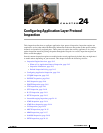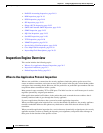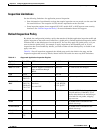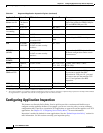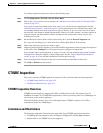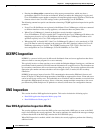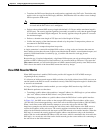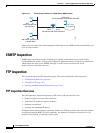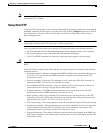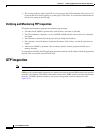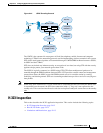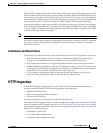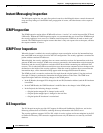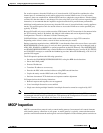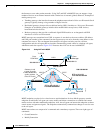
24-9
Cisco ASDM User Guide
OL-16647-01
Chapter 24 Configuring Application Layer Protocol Inspection
FTP Inspection
Note If you disable FTP inspection engines, outbound users can start connections only in passive mode, and
all inbound FTP is disabled.
Using Strict FTP
Using strict FTP increases the security of protected networks by preventing web browsers from sending
embedded commands in FTP requests. To enable strict FTP, click the Configure button next to FTP on
the Configuration > Firewall > Service Policy Rules > Edit Service Policy Rule > Rule Actions >
Protocol Inspection tab.
Note To specify FTP commands that are not permitted to pass through the security appliance, create an FTP
inspect map according to the “FTP Class Map” section on page 24-43.
After you enable the Strict option on an interface, FTP inspection enforces the following behavior:
• An FTP command must be acknowledged before the security appliance allows a new command.
• The security appliance drops connections that send embedded commands.
• The 227 and PORT commands are checked to ensure they do not appear in an error string.
Caution Using the strict option may cause the failure of FTP clients that are not strictly compliant with FTP
RFCs.
If the strict option is enabled, each FTP command and response sequence is tracked for the following
anomalous activity:
• Truncated command—Number of commas in the PORT and PASV reply command is checked to see
if it is five. If it is not five, then the PORT command is assumed to be truncated and the TCP
connection is closed.
• Incorrect command—Checks the FTP command to see if it ends with <CR><LF> characters, as
required by the RFC. If it does not, the connection is closed.
• Size of RETR and STOR commands—These are checked against a fixed constant. If the size is
greater, then an error message is logged and the connection is closed.
• Command spoofing—The PORT command should always be sent from the client. The TCP
connection is denied if a PORT command is sent from the server.
• Reply spoofing—PASV reply command (227) should always be sent from the server. The TCP
connection is denied if a PASV reply command is sent from the client. This prevents the security
hole when the user executes “227 xxxxx a1, a2, a3, a4, p1, p2.”
• TCP stream editing—The security appliance closes the connection if it detects TCP stream editing.
• Invalid port negotiation—The negotiated dynamic port value is checked to see if it is less than 1024.
As port numbers in the range from 1 to 1024 are reserved for well-known connections, if the
negotiated port falls in this range, then the TCP connection is freed.
• Command pipelining—The number of characters present after the port numbers in the PORT and
PASV reply command is cross checked with a constant value of 8. If it is more than 8, then the TCP
connection is closed.



